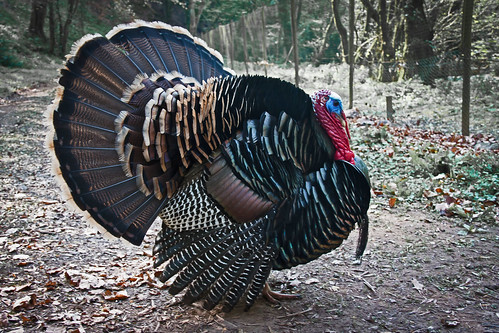 Shoeing the Goose misericord carving photographed by Giles C. Watson
This blog post is an update on one of the most popular posts ever published on this blog. First published for Thanksgiving 2008, people from all over the world have remarked on this unusual bit of history, which is little known but can always fill in the gaps of a slow conversation with the relatives on a holiday afternoon.
Shoeing the Goose misericord carving photographed by Giles C. Watson
This blog post is an update on one of the most popular posts ever published on this blog. First published for Thanksgiving 2008, people from all over the world have remarked on this unusual bit of history, which is little known but can always fill in the gaps of a slow conversation with the relatives on a holiday afternoon.
Be thankful for many things this Thanksgiving. Among them: be thankful you don't have to shoe turkeys or help them with their lameness problems. Turkey feet were a major concern up until 100 years or so ago, when the railroads took over transporting livestock to market. Up until then, turkeys took to the highway on foot to be sold in the big cities. Unfortunately, turkey feet weren't made for trotting.
If the conversation lags around the dinner table during your Thanksgiving feast, pick up a drumstick and speculate straight-faced to some young relative, "Ever notice that no one ever eats turkey feet?"
Chances are, it never occurred to a child to question why the drumstick is an amputee.
Then answer your own question nonchalantly: "They used to shoe turkeys, you know."
Then wait. It's coming.
All eyes will turn to you. In-laws will raise eyebrows. Children will hold you in high esteem. Any dogs lying in wait will wag their tails.
And the medallion above, from a medieval church, proves it, even though that is a goose carved into a misericord, a sort of jump-seat ledge in church pews. (I highly recommend following the link to
Giles Watson's site.) The goose appears to be stabilized in a stock and the farrier is hammering on its webbed foot.
Before railroads, the only way for turkeys and geese to get to market was to herd them along country roads. Drovers would purchase or consign them from multiple farmers and move great flocks toward the cities so they could be sold for Thanksgiving or Christmas dinners.
 |
| How far do you think this turkey would be able to trot? Would he look the same when he arrived at the market? (Mark Robinson photo) |
You would hear the poultry flocks, and see the dust clouds, long before they passed through your town. The poultry could eat among the stubble of harvested fields as they went. The drover didn't hurry them too much, since fatter birds meant higher prices for him.
Historically, New England writers like Hawthorne and Emerson wrote complaining comments about the huge flocks of turkeys clogging up the roads and impeding the post or the stagecoach.
Click here to listen to a Vermont Public Radio lecture about the great turkey droves to Boston for Thanksgiving.
The problem was that the birds' feet and claws weren't cut out to march a few hundred miles. Turkeys were famous for just refusing to move, or they would roost up in trees for the night and not come down in the morning, perhaps because their feet were sore. Geese apparently were even more lame than turkeys because of their webbed feet.
Cattle, too, had a hard time marching to market, and were often shod along the way. In fact, farriers were in great demand to accompany drovers so that the cattle could be shod or attended to as needed along the route. Even pigs and sheep and goats had to be shod occasionally, although the old animal husbandry books tell us that pigs preferred woolen socks with a leather sole to shoes.
 |
Buying the Thanksgiving turkey, circa 1910; double-click to enlarge and see detail. Library of Congress image
|
The drover's wagon followed slowly behind the drover, who was often on foot, with his dogs. The wagon picked up strays, or sick or lame birds. They stopped at drovers' inns, and pastured stock in rented or loaned fields (and trees) overnight.
I don't know how the geese were shod in Europe, but I have read that is was some crafty New Englanders who figured out a simpler way to do it. They developed a series of pits along the drovers' routes. In the first pit was warm tar; the turkeys and geese were herded into the pen and left for a bit, then moved to the second pen, which was sand. The sand, of course, stuck to the tar and made a gritty set of galoshes for the birds. About the time the tar wore off, they would arrive at the next set of pits.
It gives a new twist to the expression, "tarred and feathered", not to mention a "turkey trot".
It also explains why turkeys are rarely, if ever, sold with their feet still attached to their drumsticks.
|
|
| Some cooks add these little paper "turkey feet" if serving the whole bird on a platter. The tradition of roasting poultry without their feet may have a very practical origin. Photo courtesy of BenFrantzDale on Flickr.com |
Giles introduced me to an ancient
Reynard the Fox ditty:
"It’s easier to revive a corpse
Robbed from a hangman’s noose
Than to stoop with iron nails
And shoe your grandma’s goose.
Bend your back, you farrier,
The goose foot on your knee,
And watch the locals gather round
And chortle for to see.
It’s easier to make sure a tooth
That’s grey and hanging loose
Than to stoop with iron nails
And shoe your grandma’s goose.
And if the goose should give a honk
As you are a-nailing
You’ll never make a goose’s smith –
‘Tis a sign that you are failing.
You’ll tear your hair out, feathers fly,
It won’t be any use,
For I’d rather shoe my grandma
Than shoe my grandma’s goose."
Happy Thanksgiving! I'm very thankful for the people who read this blog and support Hoofcare Publishing and are my friends, even if we have never met. Thank you, most of all, for helping the horses.
TO LEARN MORE
A history of drovers in America, including the race between geese and turkeys.
© Fran Jurga and Hoofcare Publishing; Fran Jurga's Hoof Blog is a between-issues news service for subscribers to Hoofcare and Lameness Journal. Please, no use without permission. You only need to ask. This blog may be read online at the blog page, checked via RSS feed, or received via a digest-type email (requires signup in box at top right of blog page). Questions or problems with this blog? Send email to blog@hoofcare.com.
Follow Hoofcare + Lameness on Twitter: @HoofBlog
Read this blog's headlines on the Hoofcare + Lameness Facebook Page
Disclosure of Material Connection: I have not received any direct compensation for writing this post. I have no material connection to the brands, products, or services that I have mentioned, other than Hoofcare Publishing. I am disclosing this in accordance with the Federal Trade Commission’s 16 CFR, Part 255: Guides Concerning the Use of Endorsements and Testimonials in Advertising.



















